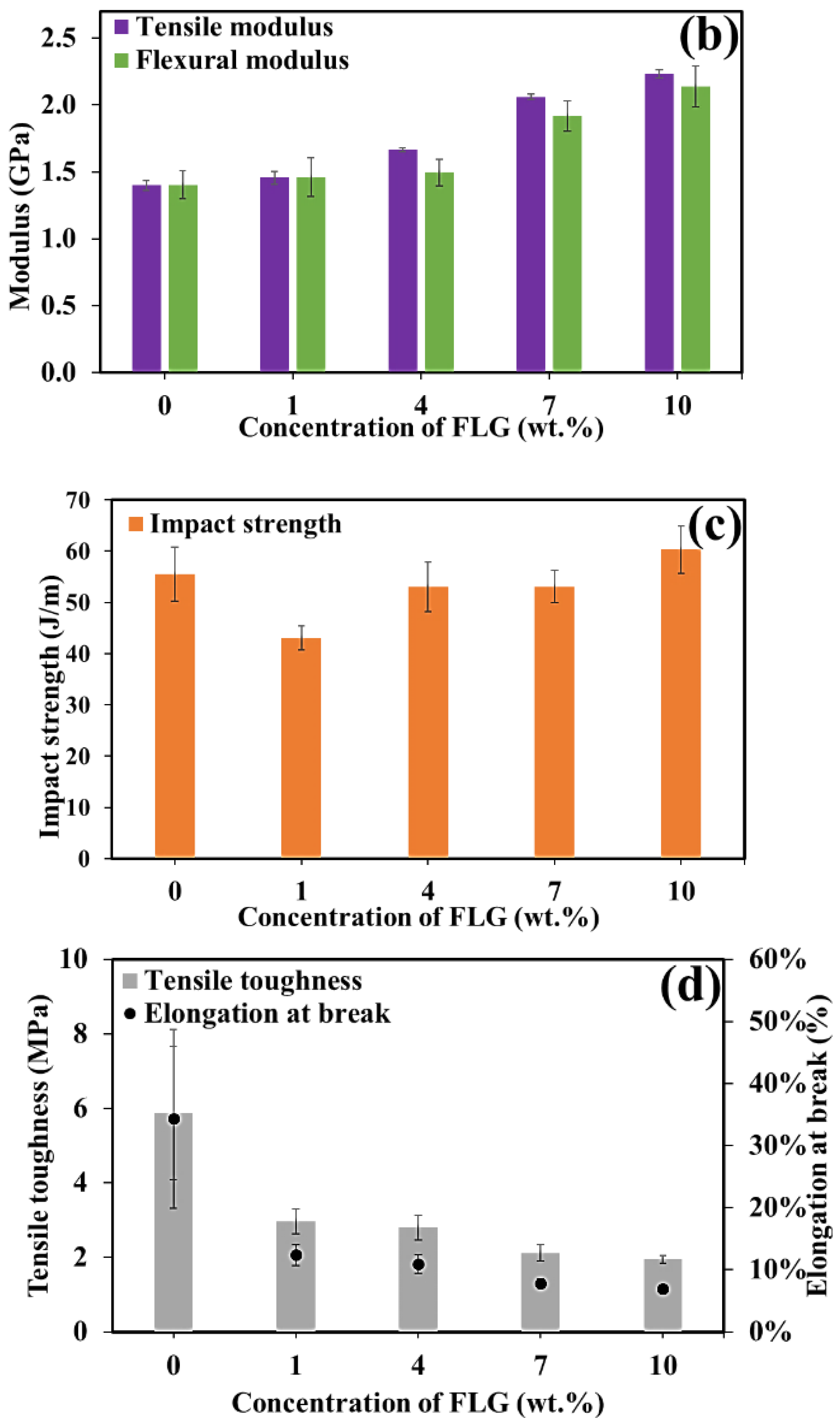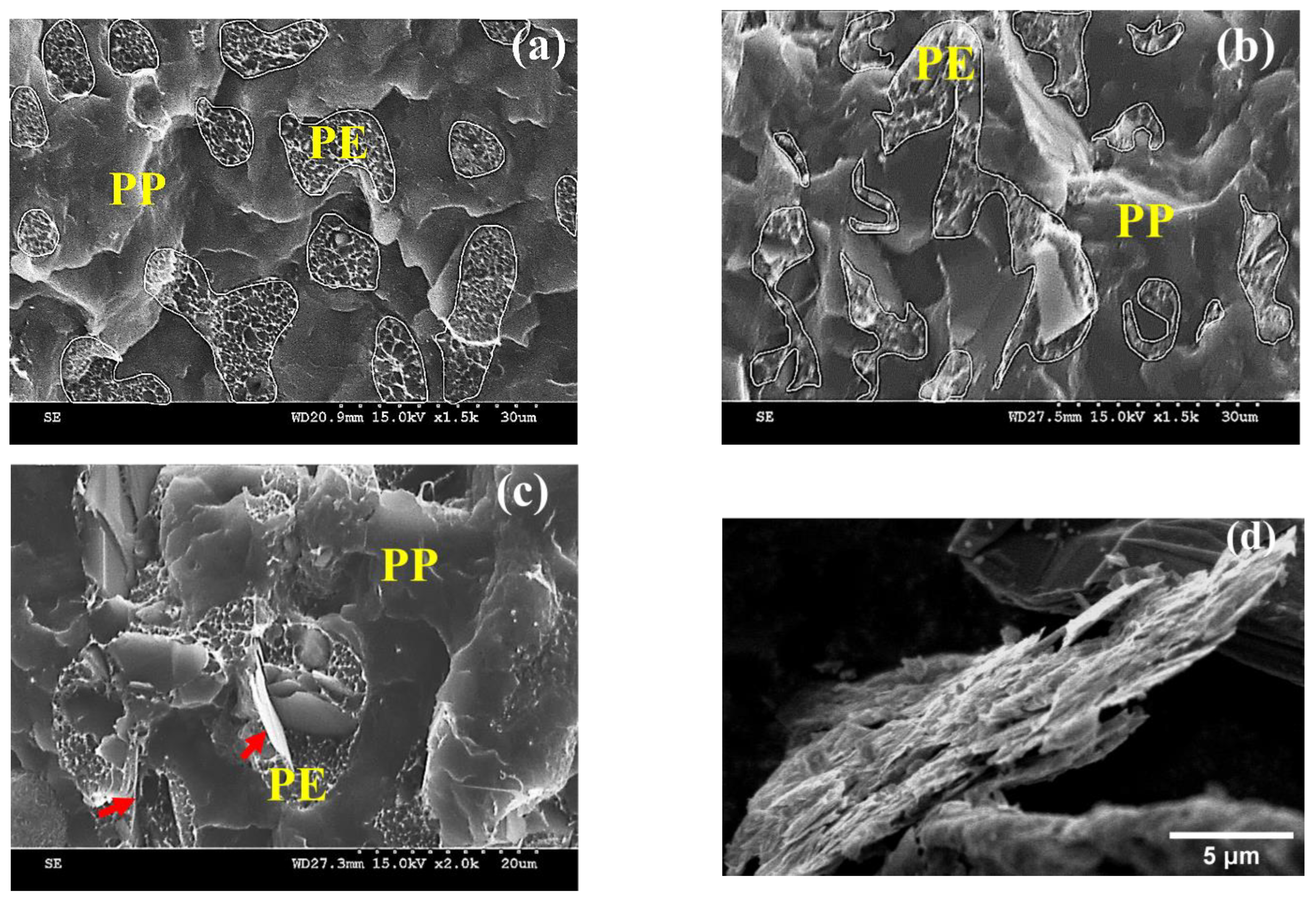Effect of Few-Layer Graphene on the Properties of Mixed Polyolefin Waste Stream
Abstract
1. Introduction
2. Materials and Methods
2.1. Materials
2.2. Processing
2.3. Characterizations
2.3.1. Melt Flow Index (MFI)
2.3.2. Rheological Properties
2.3.3. Mechanical Properties
2.3.4. Morphological Characterization
3. Results and Discussions
3.1. Rheological Properties
3.2. Mechanical Properties
3.3. Morphology
3.4. Discussion
4. Conclusions
Supplementary Materials
Author Contributions
Funding
Institutional Review Board Statement
Informed Consent Statement
Data Availability Statement
Acknowledgments
Conflicts of Interest
References
- Petigny, J.; Ménigault, C.; Luisce, T.; Harscoët, E.; David, A.; Mitsios, A.; Laberge, M.; Lysenko, D.; Moore, P.; Dimoff, A.; et al. Economic Study of the Canadian Plastic Industry, Markets and Waste: Summary Report to Environment and Climate Change Canada. 2019, pp. 1–43. Available online: https://publications.gc.ca/site/eng/9.871296/publication.html (accessed on 30 January 2023).
- Jubinville, D.; Esmizadeh, E.; Saikrishnan, S.; Tzoganakis, C.; Mekonnen, T. A comprehensive review of global production and recycling methods of polyolefin (PO) based products and their post-recycling applications. Sustain. Mater. Technol. 2020, 25, e00188. [Google Scholar] [CrossRef]
- Maris, J.; Bourdon, S.; Brossard, J.-M.; Cauret, L.; Fontaine, L.; Montembault, V. Mechanical recycling: Compatibilization of mixed thermoplastic wastes. Polym. Degrad. Stab. 2018, 147, 245–266. [Google Scholar] [CrossRef]
- Diallo, A.K.; Helal, E.; Gutiérrez, G.; Madinehei, M.; David, E.; Demarquette, N.; Moghimian, N. Graphene: A multifunctional additive for sustainability. Sustain. Mater. Technol. 2022, 33, e00487. [Google Scholar] [CrossRef]
- Vranjes, N.; Rek, V. Effect of EPDM on Morphology, Mechanical Properties, Crystallization Behavior and Viscoelastic Properties of iPP+HDPE Blends. Macromol. Symp. 2007, 258, 90–100. [Google Scholar] [CrossRef]
- Parameswaranpillai, J.; Parambil, H.P.; Sanjay, M.R.; Siengchin, S. Polypropylene/high-density polyethylene based blends and nanocomposites with improved toughness. Mater. Res. Express 2019, 6, 075334. [Google Scholar] [CrossRef]
- Blom, H.; Teh, J.; Rudin, A. I-PP/HDPE blends. III. Characterization and compatibilization at lower i-PP contents. J. Appl. Polym. Sci. 1996, 61, 959–968. [Google Scholar] [CrossRef]
- Yang, M.; Wang, K.; Ye, L.; Mai, Y.-W.; Wu, J. Low density polyethylene-polypropylene blends: Part 2—Strengthening and toughening with copolymer. Plast. Rubber Compos. 2003, 32, 27–31. [Google Scholar] [CrossRef]
- Hsieh, C.-T.; Pan, Y.-J.; Lin, J.-H. Polypropylene/high-density polyethylene/carbon fiber composites: Manufacturing techniques, mechanical properties, and electromagnetic interference shielding effectiveness. Fibers Polym. 2017, 18, 155–161. [Google Scholar] [CrossRef]
- Qiu, G.-X.; Raue, F.; Ehrenstein, G.W. Mechanical properties and morphologies of PP/mPE/filler composites. J. Appl. Polym. Sci. 2002, 83, 3029–3035. [Google Scholar] [CrossRef]
- Ramos, M.A.; Belmontes, F.A. Polypropylene/low density polyethylene blends with short glass fibers. II: Effect of compounding method on mechanical properties. Polym. Compos. 1991, 12, 1–6. [Google Scholar] [CrossRef]
- Ghasemi, F.A.; Daneshpayeh, S.; Ghasemi, I. Multi-response optimization of impact strength and elongation at break of nanocomposites based on polypropylene/polyethylene binary polymer matrix in the presence of titanium dioxide nanofiller. J. Elastomers Plast. 2017, 49, 633–649. [Google Scholar] [CrossRef]
- Parameswaranpillai, J.; Elamon, R.; Sanjay, M.R.; Siengchin, S. Synergistic effects of ethylene propylene diene copolymer and carbon nanofiber on the thermo-mechanical properties of polypropylene/high-density polyethylene composites. Mater. Res. Express 2019, 6, 085302. [Google Scholar] [CrossRef]
- Mofokeng, T.G.; Ray, S.S.; Ojijo, V. Structure-property relationship in PP/LDPE blend composites: The role of nanoclay localization. J. Appl. Polym. Sci. 2018, 135, 46193. [Google Scholar] [CrossRef]
- Fang, C.; Nie, L.; Liu, S.; Yu, R.; An, N.; Li, S. Characterization of polypropylene–polyethylene blends made of waste materials with compatibilizer and nano-filler. Compos. Part B Eng. 2013, 55, 498–505. [Google Scholar] [CrossRef]
- Karaagac, E.; Koch, T.; Archodoulaki, V.-M. The effect of PP contamination in recycled high-density polyethylene (rPE-HD) from post-consumer bottle waste and their compatibilization with olefin block copolymer (OBC). Waste Manag. 2021, 119, 285–294. [Google Scholar] [CrossRef]
- Najafi, S.K.; Hamidinia, E.; Tajvidi, M. Mechanical properties of composites from sawdust and recycled plastics. J. Appl. Polym. Sci. 2006, 100, 3641–3645. [Google Scholar] [CrossRef]
- Kazemi, Y.; Kakroodi, A.R.; Rodrigue, D. Compatibilization efficiency in post-consumer recycled polyethylene/polypropylene blends: Effect of contamination. Polym. Eng. Sci. 2015, 55, 2368–2376. [Google Scholar] [CrossRef]
- Al-Saleh, M.H. Electrical, EMI shielding and tensile properties of PP/PE blends filled with GNP:CNT hybrid nanofiller. Synth. Met. 2016, 217, 322–330. [Google Scholar] [CrossRef]
- Du, B.X.; Hou, Z.H.; Li, J.; Li, Z.L. Effect of graphene nanoplatelets on space charge and breakdown strength of PP/ULDPE blends for HVDC cable insulation. IEEE Trans. Dielectr. Electr. Insul. 2018, 25, 2405–2412. [Google Scholar] [CrossRef]
- Wei, Z.; Hou, Y.; Jiang, C.; Liu, H.; Chen, X.; Zhang, A.; Liu, Y. Graphene Enhanced Electrical Properties of Polyethylene Blends for High-Voltage Insulation. Electron. Mater. Lett. 2019, 15, 582–594. [Google Scholar] [CrossRef]
- Mun, S.C.; Kim, M.J.; Cobos, M.; Gu, L.; Macosko, C.W. Strategies for interfacial localization of graphene/polyethylene-based cocontinuous blends for electrical percolation. AIChE J. 2019, 65, e16579. [Google Scholar] [CrossRef]
- Tu, C.; Nagata, K.; Yan, S. Morphology and electrical conductivity of polyethylene/polypropylene blend filled with thermally reduced graphene oxide and surfactant exfoliated graphene. Polym. Compos. 2017, 38, 2098–2105. [Google Scholar] [CrossRef]
- Tu, C.; Nagata, K.; Yan, S. Dependence of Electrical Conductivity on Phase Morphology for Graphene Selectively Located at the Interface of Polypropylene/Polyethylene Composites. Nanomaterials 2022, 12, 509. [Google Scholar] [CrossRef] [PubMed]
- Graziano, A.; Garcia, C.; Jaffer, S.; Tjong, J.; Sain, M. Novel functional graphene and its thermodynamic interfacial localization in biphasic polyolefin systems for advanced lightweight applications. Compos. Sci. Technol. 2020, 188, 321–329. [Google Scholar] [CrossRef]
- Lago, E.D.; Cagnin, E.; Boaretti, C.; Roso, M.; Lorenzetti, A.; Modesti, M. Influence of Different Carbon-Based Fillers on Electrical and Mechanical Properties of a PC/ABS Blend. Polymers 2020, 12, 29. [Google Scholar] [CrossRef]
- Koodehi, A.V.; Koohi, A.D. Optimization of Thermal Stability of High-Density Polyethylene Composite Using Antioxidant, Carbon Black and Nanoclay Addition by a Central Composite Design Method: X-ray Diffraction and Rheological Characterization. J. Macromol. Sci. Part B 2018, 57, 660–678. [Google Scholar] [CrossRef]
- Ferreira, E.H.C.; Andrade, R.J.E.; Fechine, G.J.M. The “Superlubricity State” of Carbonaceous Fillers on Polyethylene-Based Composites in a Molten State. Macromolecules 2019, 52, 9620–9631. [Google Scholar] [CrossRef]
- Feng, Y.; Yuan, Z.; Sun, H.; He, H.; Zhang, G. Toughening and reinforcing wood flour/polypropylene composites with high molecular weight polyethylene under elongation flow. Compos. Sci. Technol. 2020, 200, 108395. [Google Scholar] [CrossRef]
- Juan, L. Simultaneous Improvement in the Tensile and Impact Strength of Polypropylene Reinforced by Graphene. J. Nanomater. 2020, 2020, 7840802. [Google Scholar] [CrossRef]
- Batista, N.L.; Helal, E.; Kurusu, R.S.; Moghimian, N.; David, E.; Demarquette, N.R.; Hubert, P. Mass-produced graphene—HDPE nanocomposites: Thermal, rheological, electrical, and mechanical properties. Polym. Eng. Sci. 2019, 59, 675–682. [Google Scholar] [CrossRef]
- Tu, C.; Nagata, K.; Yan, S. Influence of melt-mixing processing sequence on electrical conductivity of polyethylene/polypropylene blends filled with graphene. Polym. Bull. 2017, 74, 1237–1252. [Google Scholar] [CrossRef]
- Dikobe, D.; Luyt, A. Thermal and mechanical properties of PP/HDPE/wood powder and MAPP/HDPE/wood powder polymer blend composites. Thermochim. Acta 2017, 654, 40–50. [Google Scholar] [CrossRef]
- Karimi, S.; Helal, E.; Gutierrez, G.; Moghimian, N.; Madinehei, M.; David, E.; Samara, M.; Demarquette, N. A Review on Graphene’s Light Stabilizing Effects for Reduced Photodegradation of Polymers. Crystals 2021, 11, 3. [Google Scholar] [CrossRef]







| Masterbatch Polymer | Commercial Name | MFI (g/10 min) | Density (g/cm3) |
|---|---|---|---|
| R-(PE/PP) | N/A | ≥4 (230 °C, 2.16 kg) | N/A |
| PE homopolymer | Alathon H5618 | 17 (190 °C, 2.16 kg) | 0.955 |
| PP homopolymer | Polypropylene 3720 WZ | 20 (230 °C, 2.16 kg) | 0.905 |
| PP copolymer | Formolene 2620 A | 20 (230 °C, 2.16 kg) | 0.900 |
| Type of Compounds | Samples Nomenclature | R-(PE/PP) Concentration (wt.%) | Prime Polymer Concentration (wt.%) | FLG Concentration (wt.%) |
|---|---|---|---|---|
| As received mixed polyolefin waste stream | R-(PE/PP) | 100 | 0 | 0 |
| Type 1 | R-(PE/PP)/FLG = 99/1 | 99 | 0 | 1 |
| R-(PE/PP)/FLG = 96/4 | 96 | 0 | 4 | |
| R-(PE/PP)/FLG = 93/7 | 93 | 0 | 7 | |
| R-(PE/PP)/FLG = 90/10 | 90 | 0 | 10 | |
| Type 2 | R-(PE/PP)/PE/FLG = 87/13 | 87 | 13 | 0 |
| R-(PE/PP)/PP/FLG = 87/13 | 87 | 13 | 0 | |
| R-(PE/PP)/PPcop/FLG = 87/13 | 87 | 13 | 0 | |
| Type 3 | R-(PE/PP)/PE/FLG = 87/9/4 | 87 | 9 | 4 |
| R-(PE/PP)/PP/FLG = 87/9/4 | 87 | 9 | 4 | |
| R-(PE/PP)/PPcop/FLG = 87/9/4 | 87 | 9 | 4 |
| Property Variation (%) | ||||
|---|---|---|---|---|
| Properties | As Received R-(PE/PP) | Type 1 with 10 wt.% FLG | Type 2 with 13 wt.% PPcopolymer | Type 3 with 9 wt.% PP and 4 wt.% FLG |
| Tensile strength | 24 MPa | +4% | −6% | +9% |
| Tensile modulus | 1.4 GPa | +60% | −7% | +37% |
| Flexural strength | 30 MPa | +16% | −9% | +23% |
| Flexural modulus | 0.9 GPa | +46% | +1% | +34% |
| Elongation at break | 34% | −80% | +63% | −80% |
| Tensile toughness | 6 MPa | −67% | +39% | −70% |
| Impact strength | 55.5 J/m | +9% | +132% | −20% |
Disclaimer/Publisher’s Note: The statements, opinions and data contained in all publications are solely those of the individual author(s) and contributor(s) and not of MDPI and/or the editor(s). MDPI and/or the editor(s) disclaim responsibility for any injury to people or property resulting from any ideas, methods, instructions or products referred to in the content. |
© 2023 by the authors. Licensee MDPI, Basel, Switzerland. This article is an open access article distributed under the terms and conditions of the Creative Commons Attribution (CC BY) license (https://creativecommons.org/licenses/by/4.0/).
Share and Cite
Sultana, S.M.N.; Helal, E.; Gutiérrez, G.; David, E.; Moghimian, N.; Demarquette, N.R. Effect of Few-Layer Graphene on the Properties of Mixed Polyolefin Waste Stream. Crystals 2023, 13, 358. https://doi.org/10.3390/cryst13020358
Sultana SMN, Helal E, Gutiérrez G, David E, Moghimian N, Demarquette NR. Effect of Few-Layer Graphene on the Properties of Mixed Polyolefin Waste Stream. Crystals. 2023; 13(2):358. https://doi.org/10.3390/cryst13020358
Chicago/Turabian StyleSultana, S. M. Nourin, Emna Helal, Giovanna Gutiérrez, Eric David, Nima Moghimian, and Nicole R. Demarquette. 2023. "Effect of Few-Layer Graphene on the Properties of Mixed Polyolefin Waste Stream" Crystals 13, no. 2: 358. https://doi.org/10.3390/cryst13020358
APA StyleSultana, S. M. N., Helal, E., Gutiérrez, G., David, E., Moghimian, N., & Demarquette, N. R. (2023). Effect of Few-Layer Graphene on the Properties of Mixed Polyolefin Waste Stream. Crystals, 13(2), 358. https://doi.org/10.3390/cryst13020358









